Appendix 2: Workplace Mentor Tips
43 Chapter 3: Workplace Mentor Tips
3.1 Workplace Mentor Tip
Points to focus on: Small talk at meetings, eye contact and body language, and clear communication 
Small talk at meetings
In most Canadian workplaces, you will find that meetings start with a short period of small talk, or casual, informal conversation. Some appropriate topics for small talk are sports, travel, weekend plans, hobbies, or a new facility at work. Avoid topics that people may have strong opinions about or that may cause stress and anxiety.
We need to pay attention to when the tone of the meeting changes. When the meeting starts, people generally become a little more formal. The level of formality will depend on the workplace culture and can be different from one workplace to another. Make use of your noticing skills to become aware of the level of formality in your workplace.
Eye contact and body language 
Appropriate eye contact is very important when you talk to another person. When a person doesn’t make any eye contact during a conversation, people may think that the person is not being honest. When you talk to someone, it’s a good idea to look at the person and make some eye contact. Many people are uncomfortable with too little or too much eye contact.
When you talk to a group of people, make eye contact with all the individuals in the group. Doing this will make them feel included in the conversation.
Listening is a very important skill in the workplace. When you pay attention to what someone is saying, you are showing that you respect the person. At a meeting, you can show that you’re paying attention through your body language and eye contact. Face the speaker and make eye contact with the speaker. You can write down important points if you wish, but make sure to look back at the speaker and do not keep your head down. Focus on what the speaker is saying and be open to new ideas. Do not interrupt while the speaker is talking. Instead, write down your point and clarify the information when it is appropriate to do so.
Clear communication 
Good communication is a skill that many people have to learn. Effective communication strategies are important in all areas, but I will focus on meetings today. Meetings always have a start and an end time. It is important to be conscious of other people’s time during the meeting. When you speak at a meeting, your co-workers will appreciate it if you are concise. Being concise means that you express all your ideas in as short a way as you can. It is very important to speak clearly and to the point. Use the agenda to help you prepare for the meeting. The agenda is the document you get that lists all the topics that will be discussed at the meeting. You get the agenda before a meeting.
Focus on the most important points. Do not waste time on talking too much about the situation, the background information, and other less important details. Here is a simple technique to help you organize your ideas when you need to speak at a meeting. I will show you how Sima does this during the meeting:
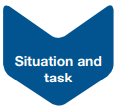 |
Start with the situation and task. Note how Sima does this:
“Well, we got a complaint from Security that some of our tenants are not following the instructions on using the loading docks for unloading. Some are using the main mall entrance.” |
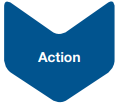 |
Next talk about the action, or what you did in the task. Notice how Sima does this:
“Last week, we sent out an email with our delivery policy to all of our tenants as a friendly reminder. We also posted the policy on the walls and the service elevators. We followed up with security personnel to check how things were going. |
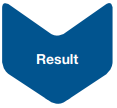 |
Finally, mention the result. Notice how Sima does this:
“They said there have been no issues this week. We will follow up again in two weeks.” |
3.2 Workplace Mentor Tip
Workplace email 
A very important and common workplace communication is the email. You are most likely already familiar with it. Here are some important tips about email in the workplace:
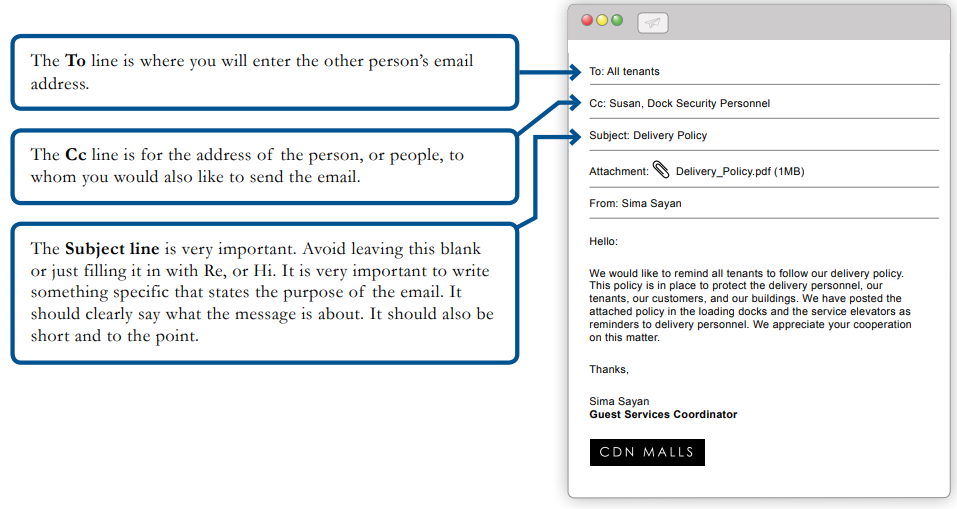
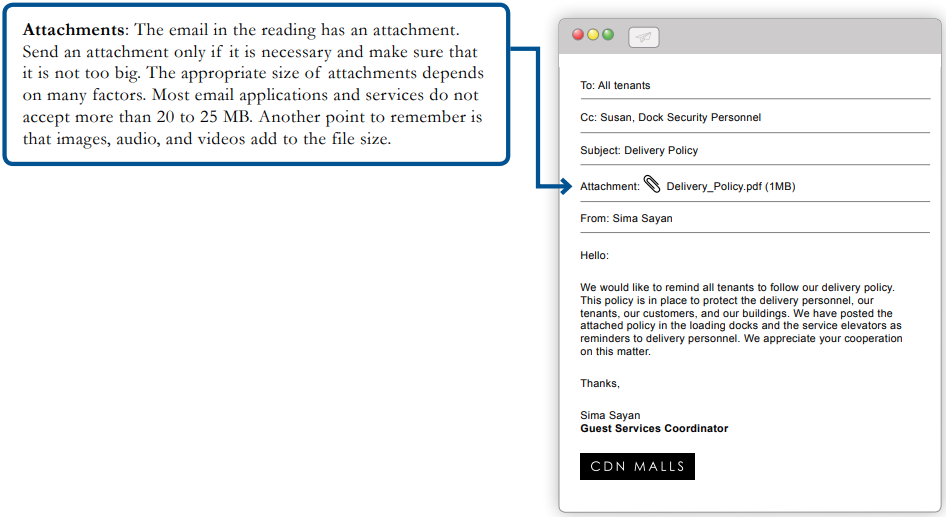
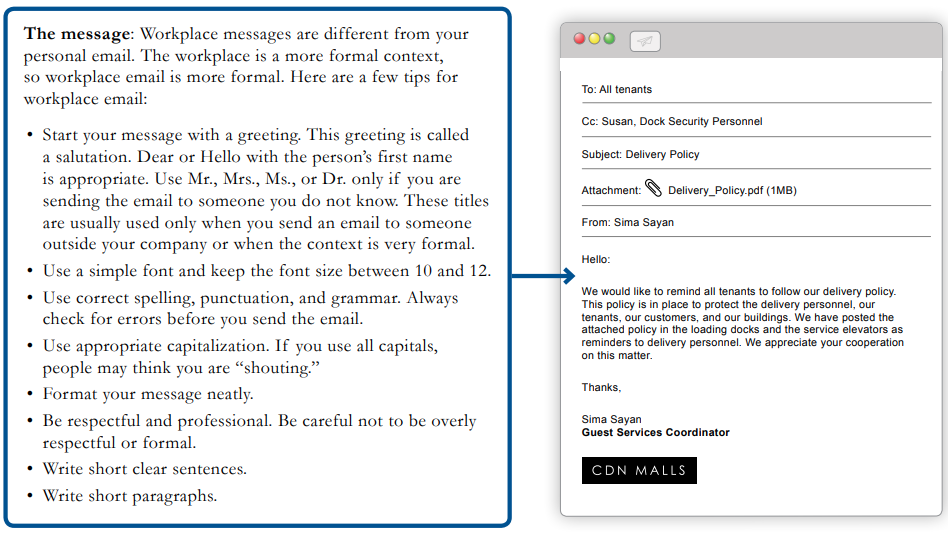
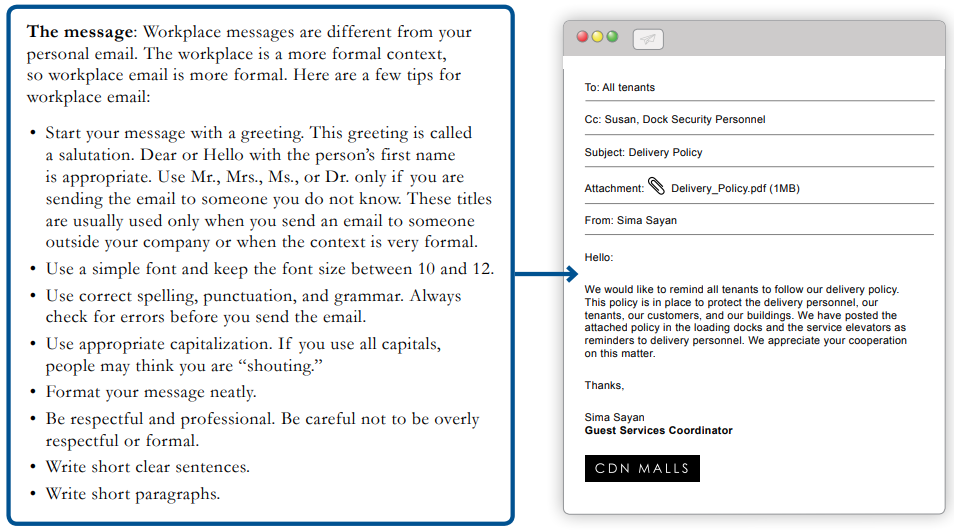
3.3 Workplace Mentor Tip
Understanding presentations 
In the workplace, you will hear both conversations and talks, or presentations. You might attend a talk on health, safety, or a new procedure. Sometimes, these talks or presentations can happen within meetings. Here are some tips to help you understand a talk or presentation:
- Pay close attention to the introduction of the talk. The speaker will tell you what to expect in the talk.
- Think about what the speaker is saying. Use your knowledge of the topic to understand the speaker.
- Listen for cues or signal words; for example, first and next. The speaker will use these cues as signposts to help you understand him/her. In his talk, Tim Robins uses the following cues to help you:
Today, I will talk about two main points …
At the end of the talk, …
Now, to the first part of my talk …
Let us first look at …
So, to summarize, …
Ask if you don’t understand something. You can clarify the information during the question and answer period at the
end of the talk. If you don’t get a chance to do this, you must check with other coworkers who attended the talk.
3.4 Workplace Mentor Tip
Formality in workplace email and email etiquette
Formality in workplace email 
When you write a personal email to a family member or a friend, you are generally very casual and informal. Obviously, a workplace email will be more formal than an email to a friend outside the workplace. But how formal should the workplace email be? This will depend on the culture of the company you work for, but in most workplaces in Canada, a workplace email will generally be either formal or semi-formal depending on the person you are writing to and the context or situation. An informal email in the workplace is often semi-formal and not as informal as a personal email. What does all this mean? Let us look at some of the features of both formal and semi-formal workplace email messages.
| Formal | Semi-formal |
|---|---|
| The recipient, or the person, getting the email, may be
someone outside the company; for example, a client or a customer. |
The recipient may be someone more familiar to you; for example, a co-worker, or your immediate supervisor. |
| The situation may be a serious one; for example, a complaint. | The situation is generally routine and not serious. The message may include a request for something that will need some effort on the recipient’s part. |
| The message will have formal words and phrases; for example,
“I was wondering if we could …” or “We would be very grateful if …” |
Most of the language will be informal and casual. Some
parts can be more formal if asking for a favour or asking for something that will need some effort on the recipient’s part. |
| The message may start with Dear Mr./Mrs./Ms. plus a last name and end with Sincerely. | The message may start with Hello/Hi and a first name and end with Regards, Thank you, or Thanks. |
Email etiquette 
Etiquette is accepted polite behaviour. Following email etiquette is important to show you are professional. Here are a few important points:
- Always be respectful and friendly.
- Include attachments only if necessary. If you include attachments, make sure they are not too big.
- Use proper capitalization. Not using capitals can be seen as being lazy. Using all capitals can be seen as being rude—it’s
like shouting at someone. - Avoid forwarding jokes or non-business messages.
- Avoid using chat talk; for example, using the letter “U” instead of the word “you,” or the letters “CU” for the words “see you.”
3.5 Workplace Mentor Tip
Reflection in the workplace 
Reflection is examining your own behaviour and actions in a situation. It can also include examining another person’s behaviour and actions.
It is very important to reflect so you can develop and grow. Reflection can help you see your strengths and identify areas for improvement. When you reflect, it is a good idea to first look at strengths, and then look at what needs to be improved. Most companies in Canada appreciate employees who can reflect because it almost always leads to self-development.
Looking at the content of this chapter, the following may be opportunities for reflection for the people involved:
- Paul, on how he had communicated
- at the meeting
- with Raja by email
- Sima,
- on whether she had communicated effectively and appropriately to her tenants in writing.
- on whether she and her team had taken all the necessary steps to make sure the delivery policy would be followed in
the future. - on whether she had communicated effectively to her team about how to prevent unwanted people entering the office
areas.
- Tim, on his presentation skills and if he had delivered his message effectively


